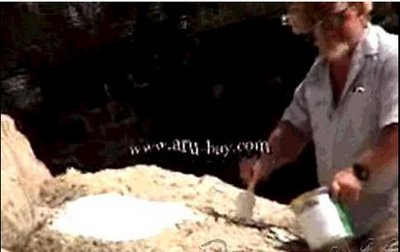THAT WASN'T LUMINOL
It was claimed that these men painting the rocks were using Luminol, a substance which police use to detect even the smallest trace of blood. Luminol wasn’t used on those rocks…that is paint. Luminol comes in powder form and is specifically mixed and sprayed onto an area in the dark. Any evidence will glow.
Why were they painting the rocks? Does paint destroy blood or DNA evidence? Those photos were taken only a day or two after Natalee disappeared.

In a crime scene, large pools of spilled blood are easy to spot. But what about blood that's been washed away? Enter luminol.
Luminol is a chemical that glows greenish-blue when it comes into contact with blood — even traces that are years old. To be exact, it reacts to hemoglobin, an oxygen-carrying protein in red-blood cells. Luminol is so sensitive, it can detect blood at 1 part per million. In other words, if there is one drop of blood within a container of 999,999 drops of water, luminol will glow.
Investigators typically use luminol at crime scenes where no blood is visible. They spray the chemical over a wide area in near-total darkness, so any reaction is obvious. Officers then photograph or videotape the result, using a flash technique that picks up the glow while making the area around it visible and identifiable on film, so the context of the crime scene isn't lost.
But does a glow mean there's blood present? Not necessarily. Luminol reacts to some metals, paints, cleaning products and plant matter. However, the chemical's reaction to each differs in intensity; metals, for example, cause an immediate glow that quickly fades, while blood glows longer. A specialist can tell the difference, and then perform more conclusive tests to determine whether the blood is human.
Luminol also can point the way to further evidence or even to how events might have unfolded. For example, if luminol sprayed on a carpet produces a glow, officers might peel back the rug to reveal a floorboard soaked with blood. Or perhaps the glow discloses the direction in which a criminal walked or dragged a body, or whether the victim was shot from behind or above.
So, to anyone thinking that a carpet cleaner or a sponge and soap will erase evidence of their crime, take note. This is one stain that cannot be "shouted out."









2 comments:
Excellent article!!! Very illuminating you might say...Of course Aruba forensics uses whitewash out of a 5 gallon bucket which in a way is very illuminating about ALE as well..I also heard they were marking the rocks with luminicent paint so aircraft could have a reference point on there grid search which makes sense since I know for a fact we did the same in the Air Cav except we use smoke not paint...I saw Joe T. [sloots] lawyer on Greta tonite putting out more spin on how the room key[natalee's room] was used at 1;26 AM and 3:22 AM and 3:36 AM...but there were multiple keys for that room because natalee had room mates she was not alone...plus the HI video does not show natalee using it or her room mates...so in other words more BS as usual from Joe T....Aruba,The happy little island stays on its course to no where...
From those who already have Dave Holloway's book, they say that Dave addresses the very same issue with the room key in the book. He says it is he that got the print out from the hotel clerk and thoroughly investigated it. He says the last time Natalee used the key was at 7 p.m. the evening of May 29.
Guess we will have to wait for his book to know more.
Post a Comment